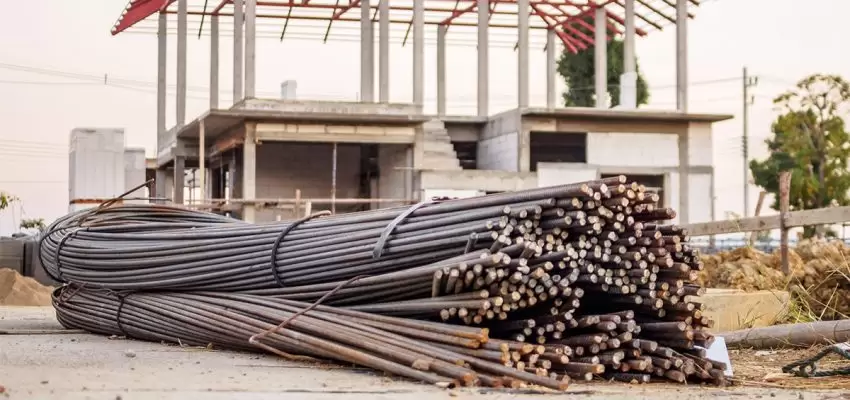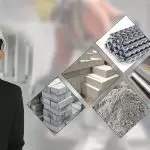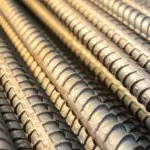The TMT bars prove to be the backbone of our daily lives, from the houses we live in, the offices we work at, the bridges, the flyovers we cross, the structures we see, and everything else. In the realm of modern construction, the TMT bars or TMT saria are the structures that impart high levels of strength, durability, and reliability in diverse construction projects. India is a country that is facilitated by growing urbanization and an ever-evolving construction industry. The need for the building of strong and sturdy structures that can withstand the test of time is more than ever and this makes the TMT saria the key indispensable component of the modern construction industry. Without these elements, the building of structures would be much less robust and way more expensive.
Post your Requirement
What Are TMT Bars or TMT Saria?
The TMT or Thermo-Mechanically Treated bars refer to the high-strength reinforcement bars that are typically used to reinforce concrete in the building of diverse kinds of structures. They are manufactured by a unique thermomechanical process that makes the outer core of the structures hard along with a soft inner core thereby making the structures flexible as well. TMT bars are the cornerstone of civil engineering with their role in providing the structural framework for different buildings and other structures. They offer a perfect balance of strength, flexibility, and durability thereby making the structures a superior and reliable option as compared to traditional materials.
Read Also: TMT Bar Price in India
Manufacturing Process of TMT Saria
The advanced manufacturing process of the TMT bars is credited for the unmatched strength and durability of the structures. To understand how the TMT bars offer incredible versatility to a wide range of applications, you first need to have a brief understanding of how it is given such remarkable properties. Let’s dive deeper into the manufacturing process of the TMT Saria.
- Raw Materials Selection: For the manufacturing of high-quality, sturdy TMT steel bars, high-quality billets, typically low-carbon steel, are first selected as the raw materials for the process. The quality of the raw material at this stage plays an influential role in determining the properties and reliability of the final TMT saria.
- Hot Rolling: Once the billets are ready, these billets are heated at high temperatures around 1100°C to 1200°C. These molten structures are then passed through a rolling mill to give a uniform shape to the bars. The thickness and properties are uniform throughout the long bars.
- Quenching: Immediately after rolling, the red hot steel bars are passed through a water cooling system to harden the outer layer of the structures while maintaining the soft core of the inside. This process is called quenching and it rapidly hardens the surface, also creating a hard layer called martensite outside the bar.
- Self-tempering: The inside of the TMT steel bars cools down gradually. This causes changes in the inside layer promoting the development of different types of steel phase mixtures called ferrite and perlite, which are not as hard as martensite but are more flexible. This stage is also facilitated by the outward movement of the heat of the inner core that tempers the martensitic layer and creates an even tougher surface on the outside. This ensures the bars achieve a perfect balance of ductility and strength free from residual stress.
- Atmospheric Cooling: This is the last stage that finalizes the TMT bar properties and features. In this stage, the TMt saria are cooled at room temperature allowing the structures to retain their strength, flexibility, and durability.
What Are The Properties Of TMT Bars?
- High Strength: These bars can withstand heavy loads during construction because of their high tensile strength.
- Ductility: These bars are ductile which means they can undergo deformation without rupturing. This property is required to absorb energy during times of disasters and sudden impacts to strengthen the toughness and durability of the structure.
- Weldability: These bars have fine weldability which makes it easy to join them together using different welding techniques. It ensures a strong connection between different structural elements and eases the construction of complex structures.
- Bendability: These bars can be easily bent without causing any cracks which means they can take shapes of different structural elements.
- Corrosion Resistant: If the bar has been properly manufactured, it has enhanced corrosion resistance. This ensures longevity and durability of the structures especially in harsh conditions.
- Fire Resistant: These bars have high fire resistance properties which lets them maintain their structural integrity at high temperatures for long periods which is one of the major reasons for safety during a fire emergency.
- Uniform Properties: These bars are manufactured with uniform properties throughout the length which ensures rational performance
Different TMT Bar Grades
There are different TMT bar grades offered by the top manufacturers in the country. The different grades of these structures typically indicate the unique properties, strength, and rigidity of the structures and the number denotes the force that needs to be applied to deform or modify the steel bars based on your specific applications.
- FE 415 GRADE: This is the grade of TMT saria that features a minimum yield strength of 415 N/mm² and comes with higher elongation properties and a cost-effective approach. They are economically feasible, sturdy, and resistant to corrosion making them good choices for small construction and also even for earthquake-prone regions.
- FE 500 GRADE: One of the most versatile TMT bar grades in the modern construction industry, these structures are facilitated by a minimum yield strength of 500 N/mm². Their high tensile strength, good stability, and elasticity make them ideal choices for heavy construction, underground construction, high-rise buildings, and other structures. Their high seismic security can also allow the structures superior protection from earthquakes and other natural calamities.
- FE 550 GRADE: The key TMT bar properties for this grade are defined by high tensile strength and greater load-bearing capacity that makes these structures ideal for large-scale construction projects, marine applications, industrial and even infrastructural projects. This TMT bar grade features structures with a minimum yield strength of 550 N/mm² but a lower elongation capacity than other options.
- FE 600 GRADE: This is the TMT bar grade that is facilitated by the highest tensile strength, elongation, and ductility as compared to all the other grades of the structures. This grade is ideal for heavy load structures as it features a minimum yield strength of 600 N/mm² and durability that can last a lifetime and withstand earthquakes, climatic conditions, and other unfavourable situations. This grade is perfect for large projects such as diverse marine structures, tunnels, and heavy-duty infrastructural projects.
Read Also: Top 10 TMT Bar Manufacturers in India
Uses of TMT Bars in Modern Construction
The TMT bars come with a superior tensile strength that makes the structures capable of withstanding high loads and external pressures efficiently. They are resistant to corrosion, fire, and earthquake damage and offer a versatile and cost-effective approach that allows the structures to offer excellence in diverse domains of modern construction. Some of the applications of the TMT bars in modern construction include the following:
-
Reinforced Concrete Structures
One of the primary uses of TMT bars is their role in the reinforcement of concrete structures. The different TMT saria are used for reinforcing the concrete in foundations, beams, columns, and slabs to give them long-term durability and reliability. Their high standards of tensile strength, along with good levels of flexibility, and resistance to cracking, make the structures suitable for high-rise buildings.
They are also used in the construction of bridges, industrial structures, and other heavy-load-bearing structures due to their incredible strength-to-weight ratio. They can impart strength to the structural elements, foundations, and other essential components of a building.
-
Earthquake Resistant Buildings
One of the essential TMT bar properties is its ductility and thus its versatility in diverse applications. The TMT saria are designed to withstand seismic forces and bend before breaking completely to let the building fall. They prove to be incredible options in earthquake-prone areas due to their ability to absorb and dissipate seismic energy without compromising the structure’s integrity.
-
Dams And Hydroelectric Structures
The different TMT bar grades are designed to offer superior water-resistant quality. This allows the structures to offer effective resistance to moisture, and also withstand the forces and pressure from water flows. This is why, the TMT bars also prove to be good options for the construction of Dams, reservoirs, and hydroelectric plants where consistent exposure to moisture is there.
-
Roads, Highways, Bridges, Flyovers
The strength and flexibility of the TMT bars make them suitable for the construction of diverse infrastructural elements. Along with their efficiency in high-rise buildings due to the necessary strength and support, and the ability to accommodate the natural movement of the structures by external forces, they are also reliable choices for the reinforcement of concrete pavement, bridges, flyovers, and tunnels.
Their ability to withstand heavy dynamic loads and resistance to environmental factors such as corrosion make them ideal choices to ensure the longevity and load-bearing capacity of roads, highways, bridges, flyovers, and other relevant structures.
-
Marine And Coastal Structures
One of the most celebrated TMT bar properties is that they offer effective resistance to corrosion due to exposure to moisture or water. This makes the structures ideal for diverse marine and coastal applications such as the construction of ports, jetties, and sea walls. These structures are consistently exposed to harsh environmental conditions, moisture, and seawater but the use of TMT bars ensures the maintenance of the structural integrity and longevity of the structures with high efficiency.
-
Towers And Transmission Lines
The TMT bars are designed to withstand high mechanical stress and harsh weather conditions, therefore making the structures great options for towers and transmission lines in the modern construction industry. They offer long-term reliability and durability for these structures and ensure effective functionality.
-
Industrial And Commercial Construction
The superior TMT bars properties also make the elements ideal choices for the construction of different industrial and commercial structures such as factories, power plants, warehouses, shopping complexes, retail stores, and numerous others. Their high standards of strength, durability, and reliability contribute to the building of sturdy structures that can withstand heavy loads and provide a safe environment for the customers and the employees working. The TMT bars are also used in the laying of pipelines and the building of underground structures as these elements are designed to offer superior stability to the structures with effective resistance to soil movement, pressure, and other pollutants.
-
Foundations, Beams, And Columns
The TMT bars are used for the construction of different types of foundations and footings due to their high standards of strength and durability. The use of TMT bars ensures the buildings can withstand the pressure exerted by the weight of the building and any additional loads.
The TMT bars are also an essential component of the basic framework of the buildings such as slabs and beams and ensure the overall structure can bear the load and stand stable for years. In this framework, the columns and pillars are also integral parts that support the weight of the building and ensure its structural integrity. The TMT bars ensure the buildings and other elements do not collapse and stand the test of time.
-
Retaining Walls And Embankments
The retaining walls and embankments play a vital role in controlling the forces of soil erosion and managing the flow of water at construction sites. The TMT steel bars offer the necessary reinforcement in these structures and ensure the overall practicality of these elements.
-
Retrofitting And Repair
Along with their efficiency and effectiveness in the construction of different structures, the TMT bars are also used for the repair and retrofitting of old buildings and structures. The TMT steel bars come with the ability to bond with existing concrete and impact strength to buildings to withstand additional stress and pressure of external forces. The TMT bars and their associated sturdiness help to extend the lifespan of the old buildings and make them the beautiful architectural wonders they are for generations to come.
Go For The Highest Quality TMT Saria To Benefit From Its Flexibility in Operations
The innovation of the TMT steel bars has revolutionized the landscape of the modern construction industry with their remarkable properties and capabilities. They offer a perfect balance of strength and flexibility to ensure versatility in diverse applications. Whether it is about earthquake-resistant buildings or marine or cold facilities, the strength, flexibility, and durability of the TMT steel bars find their application in each. As the construction industry continues to evolve, the role of the TMT bars in the creation of safe, efficient, and long-lasting structures is also evolving, therefore you need to ensure to get the highest quality, innovative elements for your structures.
Read Also: 6 Types Of Building Materials Used In Construction























Post A Comment